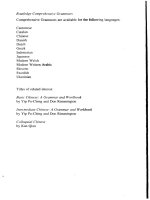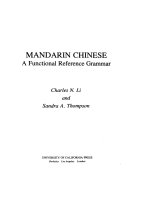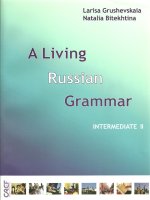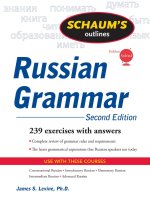a comprehensive russian grammar (blackwell)
Bạn đang xem bản rút gọn của tài liệu. Xem và tải ngay bản đầy đủ của tài liệu tại đây (2.33 MB, 632 trang )
A Comprehensive Russian Grammar
Blackwell Reference Grammars
General Editor: Glanville Price
The Blackwell Reference Grammars are essential companions for students of modern
languages at senior secondary school and undergraduate level. The volumes provide
a comprehensive survey of the grammar of each language and include plentiful examples.
The series will cover the major European languages, including French, German, Spanish,
Portuguese, and Russian.
Already published
A Comprehensive French Grammar, Sixth Edition
Glanville Price
A Comprehensive Russian Grammar, Third Edition
Terence Wade
Updated, with additional material, by David Gillespie
Advisory Editor for previous editions: Michael J. de K. Holman
A Comprehensive Spanish Grammar
Jacques de Bruyne
Adapted, with additional material, by Christopher J. Pountain
A Comprehensive Welsh Grammar
David A. Thorne
Colloquial French Grammar: A Practical Guide
Rodney Ball
An Introduction to French Pronunciation, Revised Edition
Glanville Price
Grammar Workbooks
A Russian Grammar Workbook
Terence Wade
A French Grammar Workbook
Dulcie Engel, George Evans, and Valerie Howells
A Spanish Grammar Workbook
Esther Santamaría Iglesias
A Comprehensive
Russian Grammar
Third Edition
Terence Wade
Revised and updated by David Gillespie
A John Wiley & Sons, Ltd., Publication
This third edition first published 2011
© 2011 Terence Wade
Edition history: Blackwell Publishers Ltd (1e, 1992 and 2e, 2000)
Blackwell Publishing was acquired by John Wiley & Sons in February 2007. Blackwell’s publishing
program has been merged with Wiley’s global Scientific, Technical, and Medical business to form
Wiley-Blackwell.
Registered Office
John Wiley & Sons Ltd, The Atrium, Southern Gate, Chichester, West Sussex, PO19 8SQ, United Kingdom
Editorial Offices
350 Main Street, Malden, MA 02148-5020, USA
9600 Garsington Road, Oxford, OX4 2DQ, UK
The Atrium, Southern Gate, Chichester, West Sussex, PO19 8SQ, UK
For details of our global editorial offices, for customer services, and for information about how
to apply for permission to reuse the copyright material in this book please see our website at
www.wiley.com/wiley-blackwell.
The right of Terence Wade to be identified as the author of this work has been asserted in accordance
with the UK Copyright, Designs and Patents Act 1988.
All rights reserved. No part of this publication may be reproduced, stored in a retrieval system,
or transmitted, in any form or by any means, electronic, mechanical, photocopying, recording or
otherwise, except as permitted by the UK Copyright, Designs and Patents Act 1988, without the
prior permission of the publisher.
Wiley also publishes its books in a variety of electronic formats. Some content that appears
in print may not be available in electronic books.
Designations used by companies to distinguish their products are often claimed as trademarks. All brand
names and product names used in this book are trade names, service marks, trademarks or registered
trademarks of their respective owners. The publisher is not associated with any product or vendor
mentioned in this book. This publication is designed to provide accurate and authoritative information in
regard to the subject matter covered. It is sold on the understanding that the publisher is not engaged in
rendering professional services. If professional advice or other expert assistance is required, the services of
a competent professional should be sought.
Library of Congress Cataloging-in-Publication Data
Wade, Terence Leslie Brian.
A comprehensive Russian grammar / Terence Wade ; edited by David Gillespie. – 3rd ed., rev. and expanded.
p. cm.
Includes bibliographical references and index.
ISBN 978-1-4051-3639-6 (pbk. : alk. paper)
1. Russian language–Grammar. I. Gillespie, David. II. Title.
PG2106.W33 2010
491.782′421–dc22
2010021924
A catalogue record for this book is available from the British Library.
Set in 10.5/12pt Times by Graphicraft Limited, Hong Kong
Printed in Singapore
1 2011
Contents
Preface xxv
Preface to the Second Edition xxvii
Preface to the Third Edition xxix
Acknowledgements xxxi
Acknowledgements to the Second Edition xxxiii
Abbreviations xxxiv
Introduction
1 The Cyrillic alphabet 1
2 The international phonetic alphabet (IPA) 2
Pronunciation
3 Stressed vowels 4
4 Unstressed vowels 5
5 Hard and soft consonants 7
6 Double palatalization 9
7 Non-palatalization of consonants in some loan words 9
8 Hard sign and soft sign 10
9 The reflexive suffix -сь/-ся 10
10 Effect of a soft consonant on a vowel in the preceding syllable 10
11 Voiced and unvoiced consonants 11
12 The pronunciation of -чн- 13
13 Consonants omitted in pronunciation 13
14 The pronunciation of double consonants 13
15 Stress 14
Orthography
16 Spelling rules 15
17 Use of capital and small letters in titles and names 16
Division of Words
18 Division into syllables 18
19 Splitting a word at the end of a line 19
Punctuation
20 Introductory comments 20
21 The full stop, exclamation mark and question mark 20
22 The comma: introductory comments 21
23 Uses of the comma 21
24 The colon. The semicolon. The dash 25
25 The punctuation of direct speech 28
26 Suspension points (многотчие)29
The Noun
Word formation
27 Word formation in the noun I: general 30
28 Word formation in the noun II: prefixation 32
29 Word formation in the noun III: suffixation 34
Gender
30 Masculine, feminine and neuter gender 54
31 Masculine nouns 55
32 Feminine nouns 56
33 Soft-sign nouns 56
34 Neuter nouns 58
35 Common gender 58
36 Indeclinable nouns of foreign origin 58
vi Contents
37 Indeclinable place names 60
38 Titles of books etc. 60
39 Acronyms 60
40 Alphabetisms 61
41 Stump compounds 63
42 Compound hyphenated nouns 63
43 Differentiation of gender through suffixes 64
44 Professions 65
45 Animals 67
Declension
46 Introduction 67
47 Animacy 68
48 Nouns which are used only in the singular 70
49 Nouns which have a plural form only 72
50 Declension chart 73
51 First declension: masculine nouns 74
52 The fleeting vowel 75
53 Partitive genitive in -у/-ю 76
54 Prepositional/locative singular in -/- 77
55 Special masculine plural forms 79
56 Nouns whose genitive plural is identical with the
nominative singular 82
57 Stress patterns in first-declension masculine nouns 83
58 First declension: neuter nouns in -о 84
59 First declension: nouns in -е, -ье, -ё, -ьё 86
60 Stress patterns in the plural of neuter nouns 87
61 Second declension: nouns in -а/-я 88
62 Stress patterns in second-declension nouns 90
63 Third declension: soft-sign feminine nouns 92
64 Declension of neuter nouns in -мя 94
65 Declension of nouns in -ия/-ие 94
66 The masculine noun путь 94
67 The neuter noun дит 95
68 Дти and лди 95
Contents vii
69 Declension of first names 95
70 Declension of surnames 96
71 Declension of place names 97
72 Apposition in the names of publications, towns etc. 97
73 Declension of alphabetisms 99
74 Declension of hyphenated noun co-ordinates 100
75 Agreement of ряд, большинств etc. 100
76 Constructions of the type все повернли глову 102
Case Usage
77 The nominative 103
78 The vocative 104
79 The accusative 105
80 The genitive: possession and relationship 106
81 The genitive: quantity 106
82 The genitive with adjectives 107
83 The partitive genitive 107
84 The partitive genitive in -у/-ю 109
85 Genitive in -у in set phrases 110
86 Genitive and negative 111
87 The genitive and accusative after negated verbs 112
88 Verbs that take the genitive 115
89 The dative as indirect object of a verb 118
90 Verbs that take the dative 119
91 Adjectives that take the dative 120
92 Impersonal constructions using the dative 120
93 The dative as the logical subject of an infinitive 121
94 The instrumental of function 121
95 The instrumental in constructions denoting movements
of the body 122
96 The instrumental in passive constructions 122
97 The instrumental in adverbial expressions 122
98 Use of the instrumental to denote similarity 124
99 Verbs that take the instrumental 124
100 Adjectives that take the instrumental 125
viii Contents
101 The instrumental of dimension 125
102 The instrumental as predicate 125
103 Nouns in apposition 127
Diminutive and Augmentative Nouns
104 Meanings and functions of the diminutive 128
105 Masculine diminutives 128
106 Feminine diminutives 130
107 Neuter diminutives 131
108 Other diminutive suffixes 132
109 Augmentative suffixes 132
The Pronoun
110 Personal pronouns 134
111 Use of personal instead of possessive pronouns 135
112 Use of the nominative pronoun with то 136
113 The pronoun я 136
114 The pronoun мы 137
115 The pronouns ты and вы 137
116 The third-person pronouns (он, он, он, он) 138
117 The reflexive pronoun себ 139
118 The possessive pronouns мой, твой, наш, ваш 141
119 The possessive pronouns ег, её, их 142
120 The reflexive possessive pronoun свой, сво, своё, сво 142
121 Declension of the interrogative/relative pronouns 144
122 1то, что, какй, котрый, чей as interrogative pronouns 144
123 1отрый, какй, чей, кто and что as relative pronouns 146
124 Other functions of the interrogative/relative pronouns 149
125 Declension of the demonstrative pronouns тот, тот,
такй, сей and кий 150
126 The demonstrative pronouns тот and тот 151
127 Constructions of the type примр том 153
128 The demonstrative pronoun такй 153
129 The pronouns сей and кий 154
Contents ix
130 Declension of the determinative pronouns сам, смый, весь,
вский, кждый, всческий 154
131 Сам and смый 155
132 Весь, лый, вский, кждый, лобй, всческий 156
133 The negative pronouns никт, ничт, никакй, ничй
The negative particle не 157
134 Никт 157
135 Ничт 158
136 Никакй and ничй 159
137 The ‘potential’ negative pronouns нкого, нчего 159
138 The indefinite pronouns кт-то, кт-нибудь, кт-либо;
чт-то, чт-нибудь, чт-либо; какй-то, какй-нибудь,
какй-либо; чй-то, чй-нибудь, чй-либо 161
139 The indefinite pronouns кBе-кт, кBе-чт, кBе-какй 165
140 Нкто, нчто 165
141 Нкоторый 165
142 Нкий 166
143 Other parts of speech which can also function as pronouns 166
The Adjective
144 Introduction 168
The Long Form of the Adjective
145 The long adjective: hard endings 168
146 ‘Mixed’ declension 169
147 Soft-ending adjectives 170
148 Formation of adjectives from nouns: the suffixes -н-, -ск-
and -ов-/-ев- 172
149 Adjectival endings with specific meanings 173
150 Nouns with more than one adjective 174
151 Possessive adjectives 174
152 Diminutive adjectives in -енький/-онький 176
153 Diminutive adjectives in -оватый/-еватый 177
154 Indeclinable adjectives 177
155 Attributive use of the long adjective 178
x Contents
156 Use of the long adjective with predicative meaning 179
157 Some uses of singular and plural adjectives 180
158 Adjectival nouns 181
The Short Form of the Adjective
159 Endings of the short form of the adjective 182
160 Adjectives which have long forms only 183
161 The buffer vowels -е-, -о- and -ё- in the masculine short form 184
162 Some special short forms 185
163 Masculine short forms of adjectives in -енный 186
164 Stress patterns 186
165 Divergence in stress between masculine, neuter and
plural long and short forms 187
166 The short form: usage. Introductory comments 187
167 Use of the short form to denote temporary state 188
168 Short forms: pairs of opposites 188
169 Adjectives of dimension 189
170 Delimitation of meaning by the oblique case of a noun
or pronoun 190
171 Delimitation by a prepositional phrase 191
172 Delimitation by a subordinate clause or an infinitive 192
173 The short form as predicate to infinitives, verbal nouns
and nouns with certain qualifiers 192
174 The short form in generalized statements 193
175 Position of the short form of the adjective 193
The Comparative Degree of the Adjective
176 The comparative degree. Introductory comments 193
177 The attributive comparative with блее 194
178 One-word attributive comparatives 194
179 Predicative comparative forms in -ее 195
180 Comparative short forms in -е 196
181 The short-form comparative in predicative meaning 199
182 Constructions with the comparative 199
183 The short-form comparative in attributive meaning 201
184 Other functions of the short-form comparative 202
Contents xi
The Superlative Degree of the Adjective
185 The superlative degree with смый 202
186 Всший and нзший 204
187 The superlative in -ейший and -айший 204
188 The superlative with наиблее 205
189 Other superlatives 205
The Numeral
Cardinal, Collective and Indefinite Numerals
190 The cardinal numeral 207
191 Declension of cardinal numerals 208
192 Ноль/нуль. Meanings and usage 211
193 The numeral одн, одн, одн, одн 212
194 Полтор/полтор; два/две, три, четре; ба/бе 214
195 Numerals five and above 216
196 Agreement of oblique cases of numerals полтор/полтор
to 999 with oblique plural forms of nouns 216
197 Тсяча ‘thousand’, миллин ‘million’, миллирд
‘a thousand million’, биллин ‘billion’, триллин ‘trillion’ 218
198 Declension of compound numerals 219
199 Cardinals as numerical ‘labels’ 220
200 Collective numerals 221
201 Indefinite numerals 224
202 Agreement of the predicate with a subject which contains
a numeral 226
Ordinal Numerals
203 Formation of ordinal numerals 228
204 Ordinal numerals: usage 230
Special Functions of Numerals
205 Cardinals and ordinals in fractions and decimals 230
206 Telling the time 232
207 Giving the date 235
xii Contents
208 Age 236
209 Quantitative nouns 237
210 Numerals in arithmetic 238
211 Numerals in compound nouns and adjectives 238
The Verb
Conjugation
212 Infinitive-preterite stem and present-future stem 240
213 The conjugation of the verb 241
214 The first conjugation 241
215 First-conjugation verbs with stems ending in a vowel 242
216 First-conjugation verbs with consonant stems I 244
217 First-conjugation verbs with consonant stems II: verbs
in -ать with consonant mutation throughout conjugation 246
218 First-conjugation verbs with consonant stems III: verbs
in -ти, -сть/-зть, -чь 248
219 Mobile stress in the conjugation of first-conjugation verbs 250
220 Second conjugation: present-future stems 251
221 Present-future endings in the second conjugation 252
222 Consonant change in the conjugation of
second-conjugation verbs 253
223 Stress change in the second conjugation 254
224 Irregular verbs 256
225 Deficiencies in the conjugation of certain verbs 256
226 The verb ‘to be’ 257
227 Formation of the imperative 259
228 Stress in the imperative 261
229 Verbs with no imperative or a little-used imperative 261
230 Formation of the past tense 261
231 Verbs with no -л in the masculine past tense 262
232 Mobile stress in the past tense of verbs 264
233 Formation of the future (imperfective and perfective) 266
234 The buffer vowel -о- in conjugation 267
Contents xiii
Aspect
235 The aspect. Introductory comments 268
236 Verbs with one aspect only 269
237 Bi-aspectual verbs 270
238 Formation of the aspects 271
239 Formation of the perfective by prefixation 272
240 Functions of the perfective prefixes 273
241 Semantic differentiation of aspects 274
242 Submeanings of perfectives 274
243 Formation of verbal aspects by internal modification 275
244 The formation of imperfectives from prefixed
first-conjugation verbs 276
245 Vowel mutation in secondary imperfective verbs 277
246 Secondary imperfectives based on second-conjugation verbs 277
247 Consonant mutation in secondary imperfectives based on
second-conjugation verbs 278
248 Secondary imperfectives based on monosyllabic verbs 279
249 Submeanings of some prefixed imperfectives 280
250 The differentiation of aspect by conjugation 281
251 Aspectival pairs with different roots 282
252 Verbs which are reflexive in the imperfective aspect only 282
253 Compounds of -ложить 283
254 Meanings of verbal prefixes 283
255 The imperfective and perfective aspects 293
256 Aspect in the present tense 295
257 Aspect in the past tense 298
258 Use of the imperfective past to express a ‘statement of fact’ 300
259 Use of the imperfective past to denote an action and
its reverse 302
260 Aspectival usage when emphasis is on the identity of
the person performing the action 303
261 Use of the imperfective past to denote a forthcoming event 305
262 Negated verbs in the past 305
263 Aspect in the future 306
264 The ‘logical’ future 307
265 The future in reported speech 307
xiv Contents
266 Use of the future to express repeated actions 308
267 The perfective future in warnings 309
268 Aspect in questions 309
269 Some uses of the imperfective imperative 310
270 Use of the imperative in the context of a single action 311
271 Use of the imperative to exhort and invite 311
272 A command arising naturally from context 312
273 Negative commands/warnings 313
274 Use of the perfective imperative with repeated actions 314
275 Use of the future and the infinitive to express peremptory
commands 314
276 Aspect in the infinitive. Introductory comments 314
277 Use of the infinitive to denote habitual actions 315
278 Use of the imperfective infinitive after verbs of beginning,
continuing and concluding 316
279 Inadvisable and advisable actions 317
280 A request to perform/not to perform an action 318
281 Use of the infinitive after не хоч 319
282 Use of the infinitive with пор 319
283 Use of infinitives after verbs of motion 320
Reflexive Verbs
284 Reflexive verbs: conjugation 320
285 The ‘true’ reflexive 321
286 Semi-reflexive verbs 321
287 Intransitive reflexives 322
288 Reflexive verbs with passive meaning 323
289 Reciprocal meanings 323
290 Reflexive verbs which express feelings and attitudes 325
291 Intense or purposeful action 325
292 Reflexive verbs that emphasize thoroughness 325
293 Reflexive verbs that denote potential to perform an action 326
Impersonal Constructions
294 Use of impersonal constructions to denote natural processes 326
295 Impersonal constructions with an animate accusative or dative 327
Contents xv
296 Impersonal constructions involving an external force 327
297 Expression of other meanings (chance, sufficiency etc.) 328
298 Constructions with the second-person singular 329
299 Constructions with the third-person plural 329
The Passive Voice
300 The passive voice. Introductory comments 330
301 The passive expressed by imperfective reflexive verbs 331
302 Passive meaning expressed by third-person plural verbs 331
303 Perfective reflexives with passive meaning 332
The Conditional and Subjunctive Moods
304 The conditional mood. Introductory comments 333
305 Formation of the conditional 333
306 Use of (1) the imperative and (2) the preposition без to
express conditional meanings 334
307 Use of the particle бы to express desire 335
308 Use of the subjunctive to express wish or desire 335
309 The subjunctive of purposeful endeavour 337
310 Purpose clauses 337
311 The expression of hypothesis 338
312 Concessive constructions 340
Constructions Expressing Obligation, Necessity, Possibility
or Potential
313 The expression of obligation and necessity 341
314 The expression of possibility or potential 343
Verbs of Motion
315 Unidirectional and multidirectional verbs of motion 345
316 Conjugation of verbs of motion 346
317 Imperatives of verbs of motion 346
318 Past tense of verbs of motion 347
319 ‘To go’: идт/ходть and хать/здить 347
320 Functions of unidirectional verbs of motion 348
321 Unidirectional verbs in frequentative contexts 349
xvi Contents
322 Functions of multidirectional verbs of motion 350
323 Use of the past tense of a multidirectional verb to denote
a single return journey 352
324 The verbs нест, ность; вест, водть; везт, возть 353
325 Translation of ‘to drive’ 354
326 Perfectives of unidirectional verbs 354
327 Special meanings of пойт 355
328 Не пошёл and не ходл 356
329 Perfectives of multidirectional verbs 356
330 Figurative and idiomatic uses of verbs of motion 357
331 Compound verbs of motion 358
332 Stems of compound verbs of motion 359
333 Spelling rules in the formation of compound verbs of motion 360
334 Prefixed verbs of motion 360
335 Use of the imperfective past of a compound verb of motion
to denote an action and its reverse 361
336 Figurative and idiomatic uses of compound verbs of motion 362
337 Perfectives in с- based on multidirectional verbs 363
338 Perfectives in за-, из- and на- based on multidirectional
verbs 364
Participles
339 Participles. Introductory comments 365
340 Present active participle. Formation 365
341 Stress in the present active participle 366
342 The past active participle. Formation 367
343 Stress in the past active participle 368
344 The imperfective passive participle. Formation 368
345 Stress in the imperfective passive participle 369
346 Verbs which have no imperfective passive participle 369
347 Formation of passive participles from secondary
imperfectives whose primaries have no participle 370
348 The perfective passive participle. Introductory comments 370
349 Formation (infinitives in -ать/-ять) 370
350 Stress in the participles from дать and its compounds 371
Contents xvii
351 Formation of the long-form (attributive) participle from verbs
in -ать/ять 371
352 Formation of the short-form participle from
second-conjugation verbs in -ить/-еть 372
353 Consonant mutation in participles from second-conjugation
infinitives in -ить/-еть 373
354 Formation of the long-form (attributive) participle from
second-conjugation verbs in -ить/-еть 374
355 Formation of perfective passive participles (short form)
from verbs in -ти, -чь, -зть, -сть 374
356 Long-form participles from verbs in -ти, -чь, -зть, -сть 375
357 Perfective passive participles in -т 375
358 The long form of participles in -т 377
359 Functions of short-form participles 377
360 Functions of long-form participles 378
361 Agreement of long-form participle and noun 380
362 Participial synonymy 381
363 Participles as adjectives and nouns 382
364 Participial adjectives 383
365 Distinction between short-form adjectives and short-form
participles 384
366 Impersonal function of short-form participles 385
Gerunds
367 The gerund. Introductory comments 385
368 Formation of the imperfective gerund 386
369 Stress in the imperfective gerund 387
370 Verbs with no imperfective gerund 387
371 Compensation for the lack of an imperfective gerund 388
372 The perfective gerund: formation (verbs in -ть, -сть
(д- stems)) 388
373 Reflexive perfective gerunds 389
374 Perfective gerunds with alternative forms in -я/-а 389
375 Gerunds from perfective verbs in -ти and -сть 389
376 Gerunds from perfective verbs in -чь and -зть 390
377 Functions of the gerunds 390
xviii Contents
378 Special features of constructions with gerunds 392
379 Reversal of the sequence of actions expressed by main verb
and gerund 393
380 Gerunds as other parts of speech 393
The Adverb
381 Introductory comments 395
382 Adverbs derived from adjectives 395
383 Adverbs derived from nouns 398
384 Adverbs derived from verbs 399
385 Adverbs derived from numerals 400
386 Adverbs derived from pronouns 400
387 Primary spatial adverbs 401
388 Primary adverbs of time 402
389 Уж, уж не 403
390 Ещё, ещё не 404
391 The temporal adverbs длго, давн and недвно 405
392 Primary adverbs of manner and extent 406
393 Interrelating adverbs 407
394 Тже, ткже 407
395 Indefinite adverbs (adverbs in -то, -нибудь, -либо and кBе-) 409
396 The negative adverbs нигд, никуд, ниоткда, никогд,
никк, нисклько 411
397 The negative adverbs нгде, нкуда, нкогда, ноткуда,
нзачем 412
398 Comparative adverbs 413
399 Variant forms of some comparative adverbs 414
400 The superlative adverb 415
The Preposition
401 Introductory comments 416
402 Primary prepositions and cases 416
403 Repetition of prepositions 418
Contents xix
404 The buffer vowel -о 418
405 Stress in primary prepositions 419
406 Adverbial prepositions 421
407 Prepositions derived from nouns and verbs 422
Spatial Prepositions
408 В and на + prepositional/accusative, из/с + genitive 422
409 The use of в and на with geographical terminology and
the names of organizations, buildings and parts of buildings 424
410 Nouns which may be used with в and на, but with
different meanings 426
411 Special uses of с + genitive 432
412 Uses of в and на when the dependent noun denotes an
activity, event 432
413 В and на: extension of the spatial meanings 433
Prepositions that Denote the Position of an Object in Relation to
Another Object (Behind, in Front of, Below, on Top of etc.), or
Movement to or from that Position
414 За + instrumental/accusative, из-за + genitive 434
415 За + instrumental/accusative: extension of the spatial
meanings 436
416 Перед + instrumental, вперед + genitive 437
417 Под + instrumental/accusative, из-под + genitive 437
418 Над + instrumental, поврх + genitive 439
419 МAжду + instrumental, средO, посред, напртив, прBтив,
вдBль, внA, внутрO, внIтрь, вокрIг, мOмо +
genitive 439
Pr
epositions that Denote Spatial Closeness to an Object,
Movement Towar
ds or Away from an Object, or Distance
from an Object
420 У + genitive, к + dative, от + genitive 441
421 БлOз, блзко от, вBзле, недалек от, неподалёку от,
Bколо, пBдле + genitive; блзко к, блже к + dative;
рдом с + instrumental 443
422 При + prepositional 443
423 Вдал от, далек от, подльше от + genitive 444
xx Contents
Prepositions that Denote Along, Across, Through a Spatial Area
424 По + dative; через, сквBзь + accusative; поперёк, вглубь,
вдBль + genitive 444
Prepositions that Denote Spatial Limit
425 До + genitive, по + accusative 447
Temporal Prepositions
426 Telling the time 447
427 Days 448
428 Parts of a day 449
429 Weeks, months, years and centuries 450
430 General time words 451
431 Nouns that denote stages in a process 453
432 The weather 453
433 Festivals 454
The Use of Prepositions to Denote Action in Relation to
Various Time Limits
434 The use of с + genitive, до + genitive/по + accusative
to denote terminal points in time 454
435 Use of к + dative and под + accusative to denote
temporal approach 455
436 Use of в/за + accusative to denote the time taken to
complete an action 456
437 Use of в + accusative to denote the period during which
an action occurs a stated number of times 457
438 Use of на + accusative to denote the time for which
something has been arranged 457
439 Use of prepositions to denote sequence in time
(before, after etc.) 457
440 Temporal prepositional phrases as attributes to nouns:
за + accusative, от + genitive 460
441 Positioning an event within a time span: средO + genitive,
мAжду + instrumental 461
442 Coincidence in time: при + prepositional 461
Contents xxi
Other Meanings
443 Prepositions with causal meaning 462
444 Prepositions that denote the object of feelings and attitudes 465
445 Prepositions that denote extent 467
446 Prepositions that denote purpose 470
447 Concessive meanings expressed by prepositions 472
448 По + dative/accusative in distributive meaning 473
Other Important Meanings Expressed by Prepositions
449 Prepositions that take the accusative 474
450 Prepositions that take the genitive 477
451 Prepositions that take the dative 479
452 Prepositions that take the instrumental 481
453 Prepositions that take the prepositional 482
The Conjunction
454 Introductory comments 484
Co-ordinating Conjunctions
455 Connective conjunctions 485
456 Adversative conjunctions 486
457 Disjunctive conjunctions 488
Subordinating Conjunctions
458 Explanatory conjunctions 489
459 Causal conjunctions 492
460 Conjunctions of purpose 494
461 Conjunctions of result 495
462 Conditional conjunctions 496
463 Concessive conjunctions 497
464 Comparative conjunctions 497
465 Temporal conjunctions. Introductory comments 498
466 Temporal conjunctions which render ‘before’, ‘after’,
‘by the time that’, ‘until’, ‘since’ 499
467 Other conjunctions of time 502
xxii Contents
The Particle
468 The particle. Introductory comments 505
469 The position of the particle in the sentence 506
470 The use of particles to impart different nuances of meaning 506
471 Some of the principal meanings expressed by particles 507
472 Modal functions of particles 508
473 The meanings of individual particles 510
474 The aggregation of particles for increased emphasis 517
Word Order
475 Introductory comments 521
476 ‘New’ and ‘given’ information 521
477 Relative position of subject and verb 524
478 Subject, verb, object 525
479 The position of the adjective 527
480 The position of the adverb 528
481 Sentences that contain more than one adverb or
adverbial phrase 529
482 The position of the noun or pronoun in impersonal
constructions 530
483 The position of particles in the sentence 531
484 Word order in expressive styles 531
Glossary 533
Bibliography 540
Subject index 549
Word index 566
Contents xxiii









